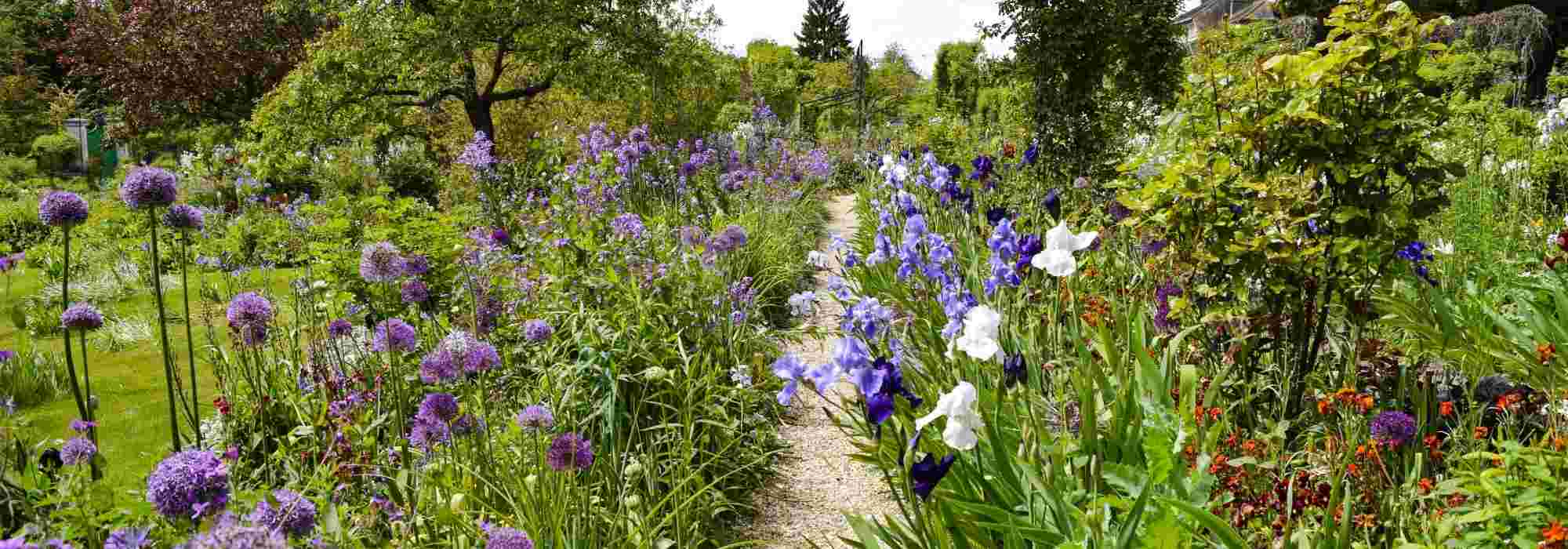
Designing a blue garden
9 landscaping tips to create a fresh and calming atmosphere in the garden
Contents
The monochrome garden is in vogue: we love its elegance that always allows for beautiful boldness in shapes and textures. While the white garden is a classic, relatively easy to implement due to the neutrality of this colour, the blue garden seems more complex, as this refreshing colour is less easy to manage in a monochrome version. It benefits from being paired with similar shades on the colour wheel to avoid the sad or monotonous effect it can convey.
So how do you design a blue garden? What style should it have? Which blue plants should you favour? To avoid any taste faux pas and to incorporate the right furniture into all this blue, we provide you with some keys and tips to make a blue garden a refined, gentle… or vibrant space!
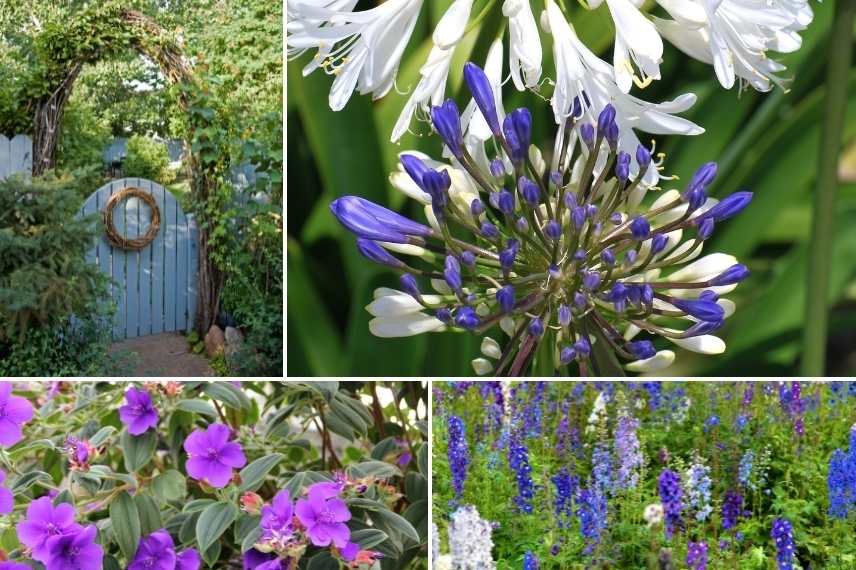
Blue makes its way into the garden! In details like a lovely gate, and mainly in the flowers and some foliage: here Agapanthus, Tibouchina, and Delphiniums
A dive into the deep blue
Each colour carries with it many myths and fantasies. Blue, a universal colour and the favourite in our Western societies, is synonymous with calm, freshness, travel, and peace. Let’s first look at some characteristics of this blue that greatly interests us in the garden:
- Blue is one of the cool colours on the colour wheel, just like green. In fact, it is the coolest colour. When entering the realm of the garden, one might mistakenly think that blue paired with green would be an unfortunate combination. This is not the case, and we will see how they actually combine beautifully through the magical play of shades and subtle pairings of neutral, pastel, or complementary colours.
- Another symbolic attribute of blue: it brings depth and distances are perceived as further away. Visually speaking, this colour of the sky and the sea conveys a sense of perspective and infinity, opening up space. It is therefore ideal for creating the illusion (a little) of a larger space.
- Blue pairs well with all other colours: this is evident in fashion and decor, and in the garden—where black and brown, the only shades to avoid, are almost absent—it creates beautiful harmonies with the cool colours nearby and contrasts with the opposite colours of yellow and orange.
- Blue reflects light: in reality, blue in full sunlight is warmed by pinkish hues, but in the shade, it remains cool. The evening light particularly enhances it, as our vision captures blue tones especially well at dusk.
- Finally, the colour blue rests the eye and reassures. This is true for the lighter shades, washed-out blues of white, sky, or lavender, but intense blues (ultramarine, sapphire…) to bluish-violet or touched with red are more vibrant colours, exuding dynamism.
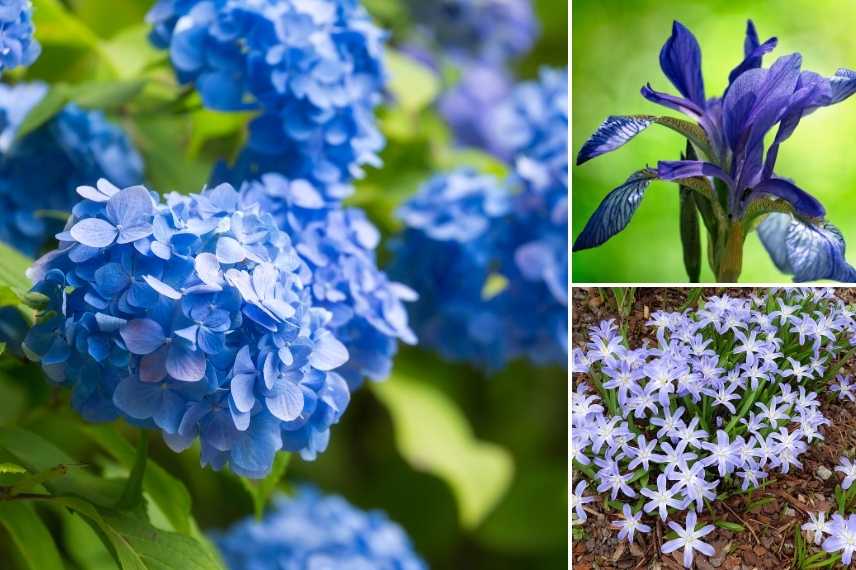 Blues are all very different, from the light blue of Chionodoxas, to the vibrant blue of Hydrangeas, to the bluish-violet of certain Irises.
Blues are all very different, from the light blue of Chionodoxas, to the vibrant blue of Hydrangeas, to the bluish-violet of certain Irises.
For what style of garden?
- Bringing depth, blue is ideal in small gardens, patios, or terraces. In small spaces, blue glazed pottery containers are particularly highlighted.
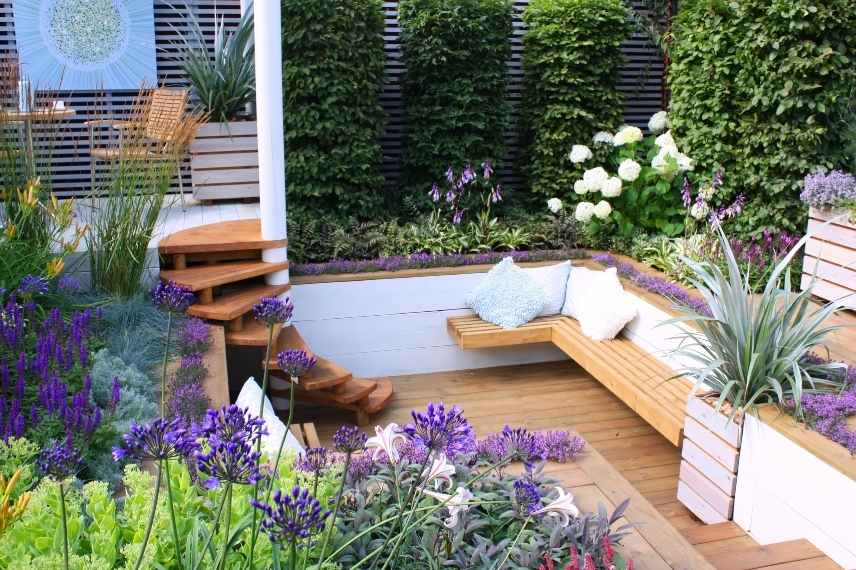
- It is possible to incorporate blue in a large garden, provided you relieve its omnipresence, as in a large space, an abundance of blue can become almost overwhelming, even pallid if it does not receive enough light. Neutral colours, such as white, cream, or a few touches of colour (yellow, orange, pink, mauve, or purple), are then introduced. The surrounding greenery will be essential to avoid overwhelming the eye.

A lot of freshness in this scene where blue and white beautifully coexist: Wood hyacinths, daffodils, and Rhododendron
- Blue is the colour of travel, lending itself beautifully to exoticism: the image of the Majorelle garden, where blue reigns (not in the flora, but in the architecture), in a spirit that is both tropical and very elegant, is irrefutable proof that this primary colour pairs divinely with green(s)! > See also Designing a garden inspired by Madeira, the island of flowers
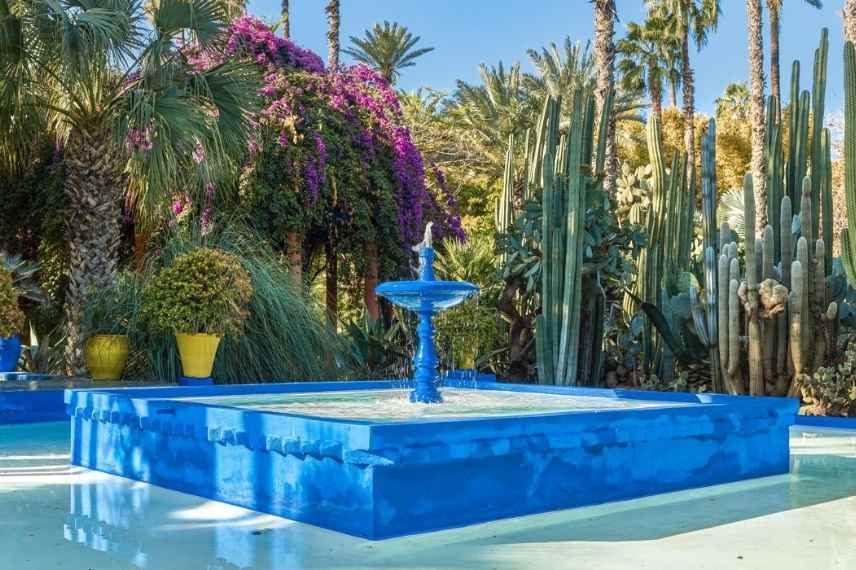
The blue of the fountains, walls, and zelliges makes a sensation with the exotic vegetation of the Majorelle garden, punctuated here and there by the purple of bougainvilleas and a few lemon-yellow spots
- A Mediterranean garden or a rock garden also offers beautiful configurations for blue flowers, which are sun-loving and often drought-resistant.
- It is an emblematic seaside garden, a holiday garden, reminiscent of the nearby blue ocean and the azure skies of the coast.
- The country garden is another type of garden that suits blue beautifully, when it is nuanced with white and other colours from pink to orange, and light textures.
- The blue garden is ideal for a garden exposed to the south or west, as it finds in these orientations many blooms that tolerate the sun very well. We will see that a shaded garden can also be designed, although with fewer flowering options.
 Blue is a symbol of escape and holidays, ideal in a seaside garden or in Provence
Blue is a symbol of escape and holidays, ideal in a seaside garden or in Provence
Mistakes to avoid and challenges of the blue colour in the garden
One must exercise caution with blue, a colour that is indeed soothing but can quickly become tiresome when used in excess. While it is a chameleon colour that pairs well with almost all shades, it is essential to temper it in a monochrome blue garden:
- Avoid overdose! Unlike a white garden, thinking 100% blue is a mistake; instead of achieving a poetic and gentle scene, the result will be cold and overwhelming, even stifling.
- Be cautious with the use of a single blue that saturates the eye: a particular harmony must be achieved within the blue spectrum, or it can quickly become tiresome. It is interesting to play with a palette of blues ranging from pale blue and candy blue to azure, ultramarine, and dark blue, including shades tinged with violet, almost purplish. Mixing them and subtly inserting a few warm colours (yellow, orange, pink) can counteract the overly cold effect of blue.
- Maintain the right proportion by using an additional colour: it should merely support the blue without ever stealing the spotlight; otherwise, it is no longer a monochrome garden.
- Do not rely solely on seasonal blooms: there are indeed many blue bulbous plants in spring… but the garden will be stunning in the early months of the year… and not colourful enough for the rest of the year.
- Avoid the blue, white, and red combination, which is too stark and cold.
- Blue hydrangeas are dreamy and are one of the most beautiful options for a blue garden, but they will only retain this colour in acidic soils (a pH below 6).
 Magnified in spring, this river of muscari against a backdrop of daffodils should remain an ancillary part of the garden that will be devoid of flowers in summer.
Magnified in spring, this river of muscari against a backdrop of daffodils should remain an ancillary part of the garden that will be devoid of flowers in summer.
Read also
7 blue AgapanthusTips to make blue pop in the garden
Blue has a calming effect on the eye. It is a unique colour that, depending on the colour it is paired with and where it is placed, provides different visual responses.
- Play with colour gradients and shades of blue: incorporating flowers a tone lighter or darker, more mauve blues or much darker, even purplish to black, enhances the impression of blue without overwhelming the eye. The deepest shades inject vitality, while pastel tones bring a great softness.
- Introduce zesty greens (chartreuse green, anise greens) that warm the atmosphere, create a strong contrast with the most vibrant blues, and bring in a lot of light: those from Euphorbias, lady’s mantle, and all green flowers like certain hellebores, but also foliage of course: grasses like Carex elata ‘Aurea’, Liriope muscari ‘Aureomarginata’, Hosta tardiana ‘June’, Miscanthus ‘Zebrinus’, Heuchera ‘Citronelle’, variegated with cream or yellow (Aucuba in a shady garden, for example)… the options are numerous in both colour and texture.

Bright blues to violet shades look stunning alongside chartreuse foliage or flowers (© Gwenaëlle David)
- Introduce neutral shades: white, cream, very pale yellow: they provide cohesion and prevent a too gloomy appearance, especially on large areas of flower beds or in naturalistic scenes.
- The complementary colour to blue, orange is useful for warming the atmosphere and ensuring visual balance in a flower bed: the more vibrant and orangey the colour, the more dynamic material you infuse into the scene… and the garden! Ideal for exotic or vibrant atmospheres. Yellow next to blue in the colour wheel also becomes interesting with bright blues. However, the complementary colour should be used sparingly to maintain the sovereignty of blue, serving merely as a colour enhancer!
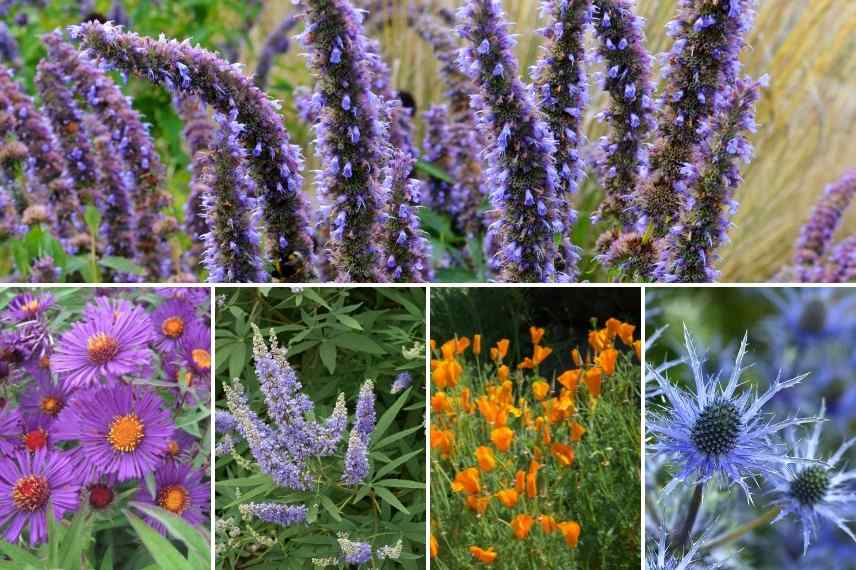
Blue from Agastaches, Vitex and thistles, tempered by the orange of the centres of Asters and California poppies
- Incorporate powdery shades (apricot or pink to mauve) if you wish to create romantic atmospheres in a cottage or English garden, to avoid an overdose of blue: ideal with soft or violet blues. You can add apricot flowers or caramel foliage if you have included the complementary colour orange and purplish foliage with the pink shade. However, do not mix all these “additional” colours: choose just one extra rosy or orangey colour and stick to it.

This bed of blue hydrangeas includes pink and violet cultivars, along with the foliage of purple Heucheras and ferns (© Carol Norquist)
- Introduce bicoloured flowers that soften while highlighting the surrounding blue: they can be blue and white, blue and orange, blue and yellow, blue and green… for example, Aconites like Aconitum ‘Eleonora’, the Lupin ‘Gentilhomme’ or ‘Kastellan’, Fuchsia ‘Blue Sarah’, many Irises and pansies, certain Columbines and sweet peas, Salvia pratensis ‘Madeline’, numerous Hydrangeas in blue and white or blue-green shades, like ‘Star Gazer Bleu’, etc.
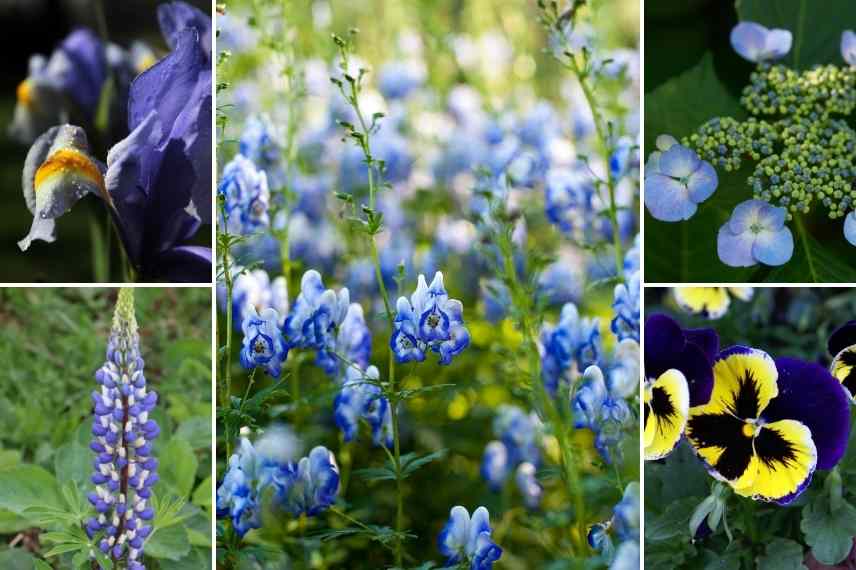
Iris, Lupin ‘Gentilhomme’, Aconitum autumnale, Hydrangea serrata, pansies
- In the same vein, prefer plants whose cultivars also exist in white such as the essential Agapanthus, Irises, Cupidones, Tradescantias, cornflowers or Eryngiums, and Hydrangeas for example, to harmonise the whole if you introduce white.
- In small doses, associate blue-green or grey-green foliage whether it be blue-foliaged shrubs, blue-foliaged perennials, bluish to greyish grasses, Irises for example or certain hostas, wormwoods or Phlomis. These silvery colours enhance a cool harmony, play the role of white by creating cohesion, highlight the blue, and enliven the pastel tones that associate perfectly in small touches.
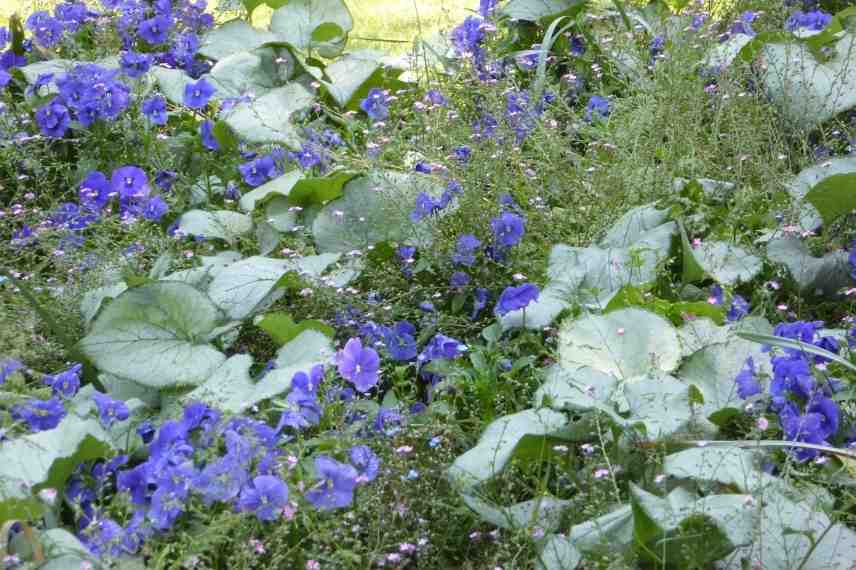
Some greyish foliage, like Brunneras alongside bright blue pansies, punctuate a flower bed (© Gwenaëlle David)
- Stagger flowering times to provide the blue garden with a visual display for many months: very early blue bulbs like Chionodoxas, Hyacinths and Ipheions, to blue flowers that last well into autumn like sages, Caryopteris, Buddleias or Vitex Agnus-castus.
- Finally, favour deciduous shrubs with orange autumn foliage to make this blue garden shine one last time before winter (blue Asters contrasting with a Parrotia persica for example or a Hamamelis).
A selection of blue flowers
While some flowers have given their name to certain shades of blue – lavender, periwinkle, gentian, indigo – several plants display a bluish hue, even though this colour is rare in nature: primarily flowering of perennial plants, but also some bushes and very beautiful blue-tinged foliage. The blue garden is a flowering garden. These are often spring flowers, but also summer ones, as blue is less common in the colder seasons, being typically associated with plants that require warmth and sunlight. Finally, some deep blue flowers are generally melliferous, just like yellow flowers: a boon for the blue garden.
Here is a selection of blue flowers that is by no means exhaustive, including perennials, bushes, annuals, climbers, as well as remarkable blue to grey foliage:
- Essential blue perennials: numerous sages including gentian sage, Phlox, Delphiniums, Agapanthus, Iris, Eryngiums and Echinops, Veronicas, Stokesias, Muscaris, Agastaches, centauries, Nepetas, perennial flax, hardy geraniums… and the too rare viper’s bugloss (from Madeira or the Canary Islands), Meconopsis, Polemoniums and Puyas in our gardens
- Annuals and biennials: Nigellas, Ageratums, Forget-me-nots, Ipomoeas, pansies, violets, borage, flax, sweet peas…
- Blue flowering shrubs: Hydrangeas, Ceanothus, rosemaries, Syringa vulgaris‘Capitaine Baltet’ and Syringa vulgaris ‘Firmament’, Caryopteris, some Hibiscus syriacus such as ‘Blue Chiffon’ or ‘Ultramarine’, some Buddleias, the lavatera ‘Blue Bird’, Vitex Agnus castus, Teucrium fruticans…
- Trees: fewer in number, especially in our latitudes: Paulownia ‘Fast Blue’, Eucalyptus, Olive, Blue Cedar and the sublime Jacaranda in coastal regions
- Climbers: Solanum jasminoides Blue, Plumbago, numerous Clematis, mauve Wisterias, Sollya heterophylla…
- Foliage: that of blue-tinged grasses such as fescues, Dasylirions, some Yucca and Agaves, including the very hardy Agave harvardiana, some Juniperus and Piceas (perfect for rock gardens), and for shade many hostas, etc.
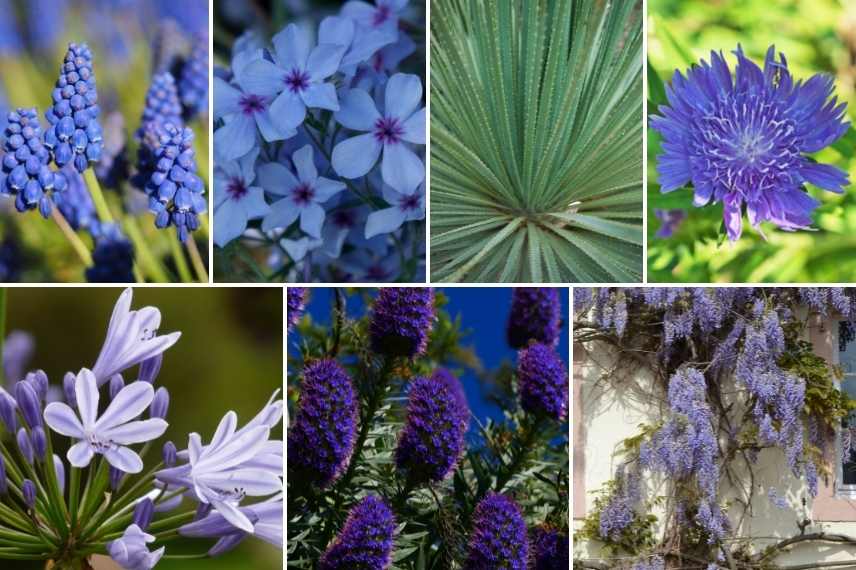 Among the many possibilities for blue blooms or shades: Muscaris, Phlox, Dasylirion serratifolium, Agapanthus, Echium candicans and wisteria
Among the many possibilities for blue blooms or shades: Muscaris, Phlox, Dasylirion serratifolium, Agapanthus, Echium candicans and wisteria
→ Read also: Blue hydrangea: the best varieties; Blue ceanothus: the most beautiful varieties and 7 blue sages to adopt in the garden.
A blue garden according to your exposure
In the sun
South and west exposures are ideal for blue flowering and foliage, as there is a wide range that thrives in sunlight. Here are some options by season to maximise floral appeal and extend the life of your blue garden:
- Spring: the bulbs that will bloom first include Chionodoxas, Scillas, Ipheions, Hyacinths, Triteleia laxa, Iris reticulata, Muscari… but also Ceanothus and rosemary, various Irises, Alliums, Freesia ‘Double Blue’, and Anchusas (Buglosses), etc.
- Summer perennials (see also previous paragraph): essential Agapanthus, Salvia nemorosa and microphylla, blue mauve Perovskias, Baptisia australis, light blue or Baptisia ‘Caspian Blue’ in bright blue, Gentians, Catananches, Lithodora diffusa…
- Autumn: Asters, numerous late-flowering salvias including Salvia uliginosa, Caryopteris, Crocus speciosus ‘Aitchisonii’, and some geraniums like Hardy Geranium ‘Orion’, etc.
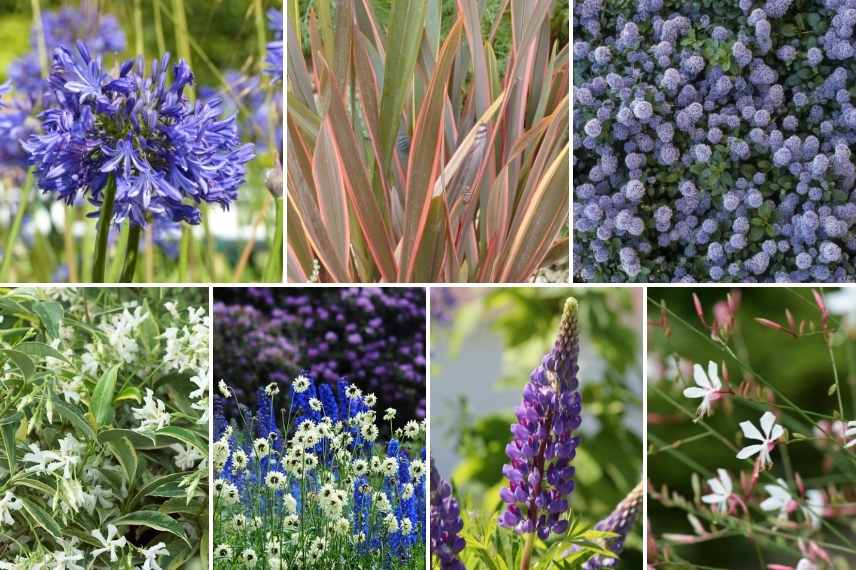
Agapanthus ‘Navy Blue’, Phormium ‘Sundowner’, Ceanothus impressus, Jasmine ‘Sun Lover’, Delphiniums and Cephalarias (© Mark), Lupins and Gaura
In the shade or partial shade
As we have seen, in the shade, blue is even cooler, but it is in shaded situations that blues are also the bluest! Place dominant blues in shaded areas or dappled light under shrubs or trees to achieve the most beautiful blue effects. In dense shade, you will need to incorporate some light-coloured blooms (cream, straw yellow, powder pink, or mauves) and play with the timing of flowering to create less dreary scenes.
- Spring bulbs such as Anemone blanda, Siberian Scillas, Hyacinths, Chionodoxas luciliae, Muscari, and the botanical tulip humilis ‘Albocaerula Oculata’: they bloom well under deciduous trees that have not yet leafed out.
- Light blue perennials: Meconopsis, Brunneras macrophylla, Columbine ‘Blue Star’, Omphalodes, Myosotis sylvatica, Corydalis ‘Craigton Blue’, Aster cordifolius ‘Little Carlow’, etc.
- Bright blue perennials: some Pulmonarias including the stunning Pulmonaria angustifolia, Ajuga reptans, numerous Columbines and Campanulas, and Omphalode cappadocica ‘Cherry Ingram’.
- Shrubs: numerous Hydrangeas macrophylla (including Hydrangea ‘Hovaria Hopcorn’ or ‘Mousseline’), but also Hydrangeas serrata in more mauve tones, Rhododendrons augustinii, all light blues to electric blues, and some amazing dwarf Rhododendrons like Rhododendron ‘Blue Silver’ or Rhododendrons impeditum with small blue flowers, including the popular ‘Blue Tit’.
- For foliage, choose one or two variegated plants to instantly brighten the area.
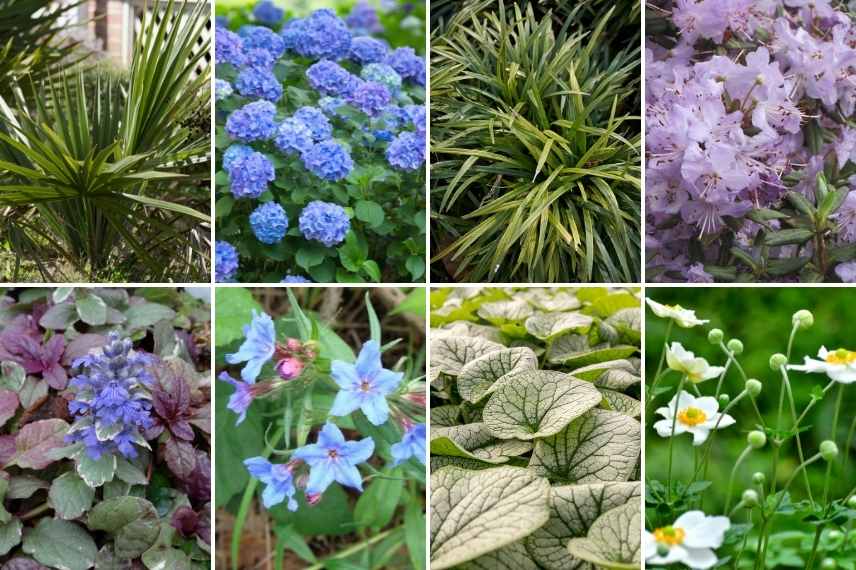
Sabal minor, Hydrangea, Carex morrowii, Rhododendron ‘Blue Silver’, Ajuga reptans ‘Burgundy Glow’, Lithospermum, Brunnera Alexander Great and Japanese anemones for the essential white touch.
A layout plan?
As we have seen, the blue garden can be envisioned in very different types of gardens. The layout will depend on the style of your garden.
- A contemporary garden that favours upright forms and dynamic or rounded inflorescences will benefit from incorporating straight, understated, geometric lines in the flower beds and paths to enhance the site’s graphic quality.
- English or country gardens will focus on soft, curving lines, with bean-shaped flower beds, for example, to create a sense of calm, which the blue will further emphasise. In larger gardens, one can create slightly different vegetated areas (blue and white, then sky blue and deep or saturated blue, mixed with mauve or violet, blue-salmon, etc.).
- Small gardens or patios can be designed in the spirit of a small plant jumble, or conversely, in a sobriety where aligned or grouped containers will be the stars of this urban cocoon.
- Exotic gardens may waver between straight lines introduced by stylised fountains and a minimalist, even modernist style to highlight the exuberance of the plantings, or alternatively, create a microcosm that aims to be more of a jumble of plants, with paths that undulate.
- Coastal gardens, especially if they have a significant slope, will be enhanced by winding pathways, with hidden nooks that will reveal, for the lucky ones, views of the ocean!
Furniture and materials
When thinking of a blue garden, how can one not evoke the famous Majorelle Garden in Marrakech and its stunning expanses of blue colour?
The sensation of blue can indeed be completely introduced or simply enhanced by the colourful touches of bright blue-painted wall sections, a lovely gate or garden shed, a fence, a pergola, glazed ceramics, and various objects scattered throughout the garden: benches and chairs, cushions, as well as a small ladder, parasol, painted shutters, lanterns, ponds, etc. However, not everyone can achieve the Majorelle effect, and we advise limiting this blue decoration to a few objects, using it as in Morocco with exotic plants that are enhanced by intense blues like ultramarine and cobalt, or in a small dedicated space.
When opting for blue flowering plants to rhythmically enhance the garden, one can place a beautiful blue pot here and there in a large space, but it is advisable to temper this blue sensation by incorporating “neutral” furniture: exotic woods like teak or Padouk with warm orange tones, wrought iron for example (raw steel can overly emphasise the metallic aspect of blue). Natural and raw materials like terracotta and warm Terracotta colours beautifully highlight the blue flow provided by the plants.
You can also simply base your design on the colour of blue shutters and frames to start thinking about a natural extension to the garden… blue. Simple, but very effective!
 Extremely flashy blue walls to a judiciously repainted door… one or two intense blue and glazed pots for a stunning effect… a few blue seating options are all threads that connect in a blue garden[/caption>
Extremely flashy blue walls to a judiciously repainted door… one or two intense blue and glazed pots for a stunning effect… a few blue seating options are all threads that connect in a blue garden[/caption>
As for pathways, blue in the garden benefits from being lightened by light gravel, or even pebbles from the seaside (especially if the garden is based on white and cream associations) or bricks in northern regions, perfect for complementing orange touches from daylilies, primroses, or avens, for example. Slate strips combined with raw wood are also a lovely way to highlight blue without overwhelming it. Choosing materials from local stones is always a plus!
Books for inspiration
If this foray into the blue garden has inspired you, we recommend a few (good French) reads:
- The Colour guide to the garden. Francis Peeters and Guy Vandersande. A bible on the use of colour!
- The Gardener’s colour book. Andrew Lawson. 2020. Ed. Jardins et Nature. Another reference work to better master colour in the garden.
- Blue: History of a colour. Michel Pastoureau. 2000. Ed. Seuil. To go well beyond the garden, a collector’s book.
- Finally, of course, the Majorelle Garden in Marrakech, a world-renowned place, with unforgettable blue accents.
- Subscribe!
- Contents
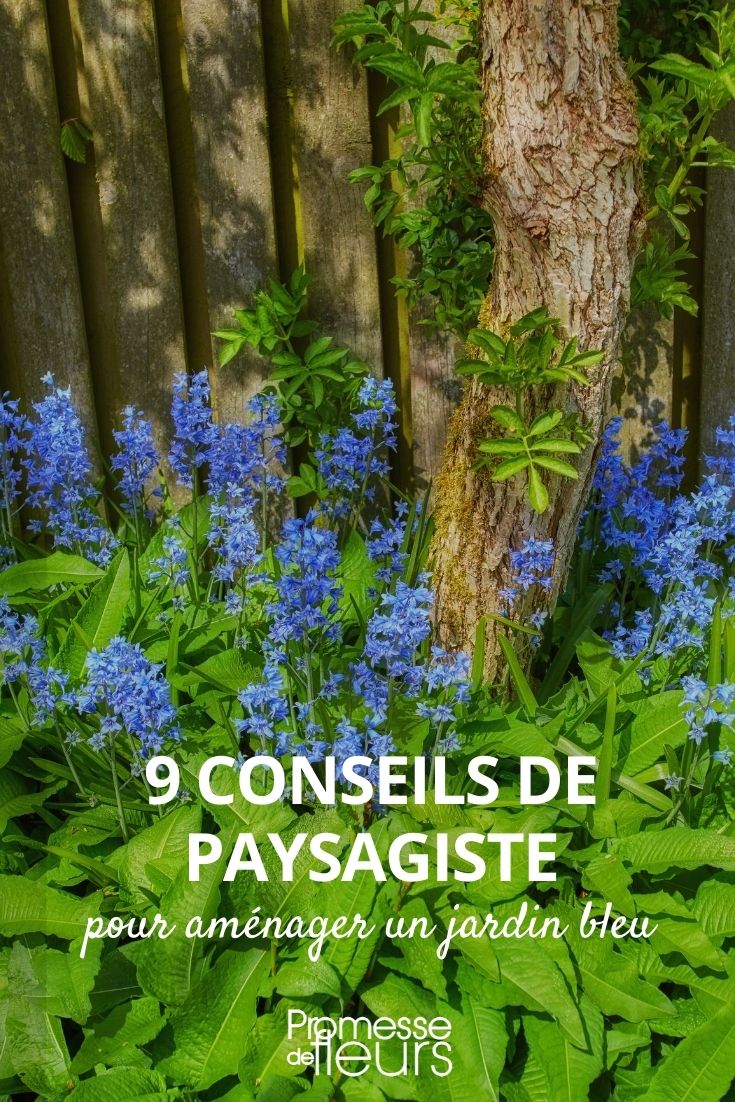































Comments